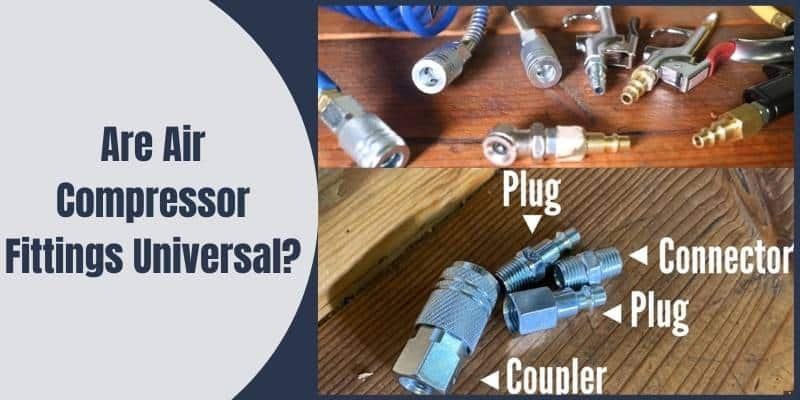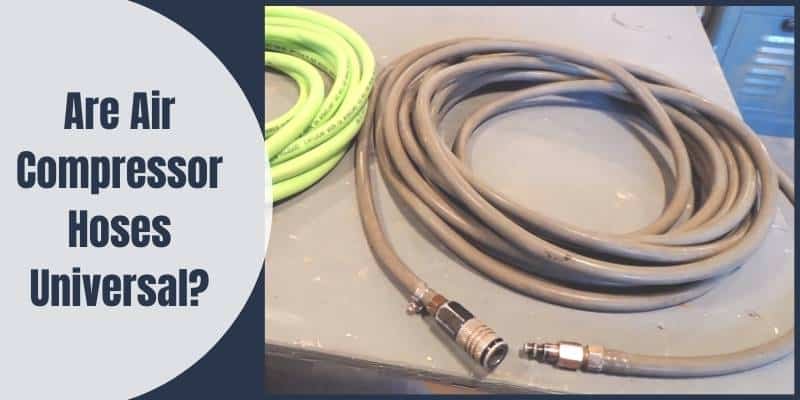Disclosure: This post contains affiliate links and I will be compensated if you make a purchase after clicking through my links. Learn More
From average handymen to homeowners, air compressors are a very useful tool. From spray painting in your house to pumping tires in your garage, there is no shortage of use for an air compressor in your home.
There are two types of air compressors: one powered by electricity and another powered by gas.
Electrically powered air compressors are recommended for home use because they make less noise and there is no risk of toxic exhaust fumes like carbon monoxide.
Still, there are some precautions you must take before using an air compressor at your home. In this article, we will guide you through some safety factors and precautions for using an air compressor indoors.

Is It Safe to Use an Air Compressor Indoors?
Is it safe to use an air compressor indoors? The short answer is yes.
If you follow the manufacturer’s guidelines properly, electric air compressors are generally safe for indoor use. They are far less dangerous than gas-powered air compressors. There is no risk of oil spillage or the emission of hazardous fumes like those in gas-powered versions.
Gas-powered tools are also much noisier than their electric counterparts. That’s why it is always recommended to keep gas-powered air compressors away from indoor use.
Keep reading till the end. We are going to discuss this topic in more detail, sharing all the information you need to use an air compressor indoors and things that you should avoid when doing so.
Types of Air Compressors for Indoor Use
There are several types of air compressors. However, they are usually classified into two major categories. They are positive displacement compressors and dynamic compressors.
Dynamic compressors suck in the air using rapidly rotating blades, then trap this air to produce pressure. They are used in large structures or heavy machinery such as airplanes.
Positive displacement compressors work with different internal mechanisms. They use these mechanisms to generate power via air displacement. Positive displacement compressors are suitable for indoor or domestic use. There are different types of positive displacement compressors. Let’s look at some of them.
1. Rotary screw compressor
2. Reciprocating piston compressor
3. Rotary vane compressor
4. Scroll compressors
1. Rotary Screw Compressor
They are the most common air compressors on the market today. They work by collecting air, sealing the air, and then compressing the air with two continuously rotating rotors. It keeps compressing the air till it reaches its target compression. It is also lubricated with an air oil mixture, which helps it increase operational efficiency.
2. Reciprocating Piston Compressor
This air compressor draws in air through the use of pistons that are in constant motion. The general idea is that one piston movement draws in air, and the other compresses it. There are two types of this air compressors: single-acting and double-acting.
3. Rotary Vane Compressor
This is another popular air compressor on the market. They are similar to the rotary screw compressor but use vanes to compress air rather than blades.
4. Scroll compressor
Also known as a spiral compressor, it works by internally compressing air or gas. It is used in vacuum pumps or air conditioners.
How to Use Air Compressors Indoors Safely?
Using air compressors comes with its own risks, especially when used indoors. Here is how you can use it safely:
Assembling The Air Compressor
It is pretty simple to assemble an indoor air compressor. It can be as easy as plugging in the hose and electrical cord. Here are a few steps to assemble the air compressor.
- If the compressor uses oil, check to make sure the oil is at least 2/3 full. If not, fill it up. Air compressor oil is relatively easy to find as well. Check your local stores.
- Satisfied with the oil level? Next, you should attach the hose to the regulator valve. The valve is located next to the pressure gauge.
- Check the electrical outlet; make sure it is a grounded three-prong outlet. Also, ensure it supplies sufficient power for the air compressor. It is a round and sometimes colored plug with a hole at the center. It should not be hard to miss.
- The last step is to plug your power tool into the hose. Twist until the power tool locks onto the hose. You can use several power tools with your air compressor. Some are air hammers, air drills, and air impact wrenches.
Operating The Air compressor
Operating the air compressor is also easy. However, there are a few things you need to check while using it.
- Test the safety valve. Pull on the safety valve and listen for the hiss of air escaping the valve. This is a good sign that the air compressor works.
- Safety first. Wear goggles, gloves, and noise cancellation plugs if you need them.
- Turn on the air compressor. Flip the switch for the air compressor, then wait for it to pressurize. You would know when it is pressurized by monitoring the pressure gauge. The needle stops moving when the air compressor tank reaches its maximum pressure.
- Adjust the pressure to match your tool’s required PSI. Your device will have a required PSI; check the box if you are unsure. Now twist the regulator knob to increase the air flowing into the hose. Watch the gauge to know when the required air has gotten into the hose.
- Operate the power tool. Always make sure to operate while air is in the tank.
Regular Maintenance of Air Compressors
You should regularly maintain your air compressors to avoid breakdowns or accident-related issues. Maintenance can sometimes mean cleaning up the reed valves. Cleaning helps you get rid of oil spills or debris. Properly maintained air compressors usually last longer.
Safety Tips and Warning While Using Air Compressors Indoor
While using the air compressor, indoor safety should be the first priority. One must follow the below safety tips in the workplace.
1. First and foremost, go through the user manual, and learn how to use it properly.
2. Use self-retracting cords.
3. Check for oil and leaks.
4. Turn it off when not in use.
5. Be attentive to abnormal sounds like knocking.
6. During usage, check to see if all pressure gauges are showing correctly.
7. Make sure the electrical outlet is properly grounded.
8. Lastly, keep the surroundings of your air compressor cool. This will reduce the risk of overheating.
What Should You Not Do with an Indoor Air Compressor?
We have seen the safety side of it, but we must avoid a few things when using air compressors indoors.
Do not apply pressured air directly to your skin.
Applying pressured air on your skin or anyone else’s could lead to serious injuries. Air as low as 15 PSI can still be harmful.
Do not use it for breathing purposes.
Unless the air system has been designed for breathing, do not use air compressors for breathing purposes. It is fatal. Imagine all that pressure hitting the lungs.
Don’t leave it unattended.
Leaving your air compressor unattended for long periods could lead to unforeseen damage. It can clog up the hose and machine with oil and other debris. This situation could lead to safety hazards.
FAQs
Do Electric Air Compressors Give off Carbon Monoxide?
Electric air compressors, unlike gas-powered air compressors, do not give off carbon monoxide. They also do not release other types of fumes. However, they consume a lot of electrical power.
Is it Safe to Breathe Air From an Air Compressor?
No, it is not. Compressed air is hazardous to the body. Breathing in the air from the air compressors could lead to lung failure and other harmful situations.
What is a Good Size Air Compressor for Home Use?
You don’t need a big air compressor for indoor use. An 8-gallon air compressor is typically enough.
Conclusion
Indoor air compressors are really useful for a lot of things. However, we must take adequate care of them and use proper safety precautions to avoid serious injuries. When selecting an air compressor for indoor use, make sure the manufacturer has an excellent safety record.


